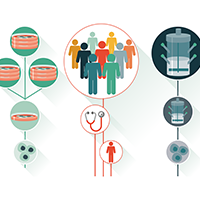A question of consistency: biopharma know-how meets bioreactor innovation in upstream bioprocessing
Cell Gene Therapy Insights 2018; 4(8), 601-606.
10.18609/cgti.2018.058
Looking at the various bioprocessing steps currently involved in the manufacture of cell therapies, where do you see the biggest opportunities for innovation and improvement?
The challenge in industrial bioprocessing is the development of a commercially viable process that delivers products in high, consistent quality. This is common to all cell types and products, be it protein production in CHO cells or the manufacturing of cell-based therapies. Compared to other cell types, stem cell bioprocessing poses unique challenges to both upstream and downstream processes. I will focus on the upstream part, however, because this is what we are experts in at Eppendorf. One of the challenges is, that unlike in biologics production, in cell-based therapy manufacturing the cell is the product. For some applications, like the treatment of GvHD, undifferentiated stem cells are needed; for others the manufacturing involves two steps – stem cell expansion and differentiation into the desired cell type. Both steps have individual requirements with respect to the process conditions and quality control, and protocols are often less mature than in biologics bioprocessing. Let’s take the medium composition as an example. As in biologics production cell-based therapy-manufacturing needs xeno-free media to meet regulatory demands and allow process standardization. In addition it requires growth factors or chemical substitutes for them, which are not cost-prohibitive. While chemically defined media are well established in e.g., CHO cell culture, they are still not available for all stem cell types. Generally said, as stem cell bioprocessing is a much younger field than biologics production, of course there is much less experience. The biggest opportunities for innovation and improvement I see in bioprocess monitoring, analysis, and control. A thorough process understanding and technical possibilities for control are the key to robust processes and products of consistent, high quality.
How much can we as a sector learn from the bioprocessing of biologics?
As said, requirements like cost effectiveness and product quality are the same in bioprocessing of biologics and stem cell-based products. Therefore we can adopt some tools to meet them. Technology and concepts for bioprocess control, experimental design, and statistical data analysis, which help in optimization of biologics production promise to be useful also for stem cell bioprocess development. Let’s look at the cultivation system first. As in protein production, cultivation in bioreactors opens up new possibilities for process monitoring and control compared to conventional cell culture flasks. In bioreactors it is easily possible to control for example the dissolved oxygen concentration and achieve conditions, which resemble the condition in the stem cell niche in vivo. Process development is sped up by parallel experimentation in small-scale systems. Parallel mini bioreactor systems allow operation of multiple bioreactors, hence reducing the number of process runs needed, while saving precious resources like media and supplements. In combination with software for the setup and analysis of Design of Experiments (DoE) studies, parallel bioprocess systems help to gain maximum information from as few experiments as possible. Gaining process understanding requires monitoring critical process parameters and analysing their influence on product attributes. This is true for biologics as well as stem cell bioprocessing. Flexible bioprocess control software that allows integration of external sensors can greatly help.
While certain experimental concepts and technologies are adaptable, cell therapy bioprocessing has its unique challenges. Quality control requires specific assays for cell identity and functionality, which are not needed for, let’s say, an antibody-producing CHO cell. Dependent on the application this includes tests on viability, senescence, the immunomodulatory properties, pharmacological response, and others. Online measurement of critical quality attributes (CQA) is a big topic in biologics production, but in the field of stem cell bioprocessing there is even more to do.
Our colleagues in the Eppendorf applications lab recently made a first step in the direction of cell characterization in real time. In a proof of concept study they integrated an Ovizio® iLine F Sensor and OsOne Software with a DASbox® Mini Bioreactor System and the Eppendorf bioprocess control software DASware® control 5. This allowed a non-invasive online measurement of the total and viable cell concentration, viability, and the average cell diameter.
One of the key issues facing the field as we see more products moving to commercialisation, is that of scale – what do you see as some of the bottlenecks in effective scalability of cell therapies?
In my opinion, one prerequisite as well as bottleneck for successful scale-up is gaining process understanding and the development of robust culture protocols at small scales. This includes among others the development of robust protocols for the differentiation of stem cells into the desired cell type. It is important that process engineers in early-stage development already have commercial-scale manufacturing in mind. For therapeutic applications, processes have to be xeno-free, for example, and have to consider the cost of goods, including media, growth factors, and consumables. Then of course the scalability of the bioprocess system is crucial.
What approaches can be applied to process development of cell therapies to help tackle these issues of commercial-scale manufacture?
For efficient scale-up, process conditions used at early stages have to be transferred to larger volumes. Stirred-tank bioreactor design has proven its value, because it allows similar vessel geometries and capabilities at different scales. This facilitates a smooth transition to larger volumes, and also offers the option of process scale-down for optimization and troubleshooting. To take an example, the Eppendorf portfolio of BioBLU® Single-Use Vessels for cell culture applications covers working volumes of 100 ml to 40 l, fitting the production volume range of many cell therapy applications. Scale-up strategies which are successfully applied in biologics process development might also be applied to stem cell bioprocessing. As already mentioned, a comprehensive process understanding is a key prerequisite for efficient scale-up. Software tools for experimental design, bioprocess control, and data analysis are of help here.
From Eppendorf’s extensive experience in protein manufacture, are there any specific bioprocessing steps for cell therapies that could benefit from approaches used for protein production?
We see indications that also cell therapy bioprocessing will benefit from perfusion technology. In protein production, perfusion processes are a hot topic, as they can deliver more product for a given bioreactor volume and therefore can save lab space and enhance flexibility. Furthermore, product quality can profit through a more constant cellular environment and constant product harvest. There is a very interesting publication by Kropp et al., demonstrating the potential of perfusion technology for the cultivation of human induced pluripotent stem cells. The authors compared the expansion of cell-only aggregates when using different feeding strategies. In perfusion mode glucose and lactate levels, pH, and DO were much more homogenous throughout the cultivation period, compared to a conventional repeated batch process. Importantly, the cell yield was almost 50 % higher. I believe, that gaining more cells in shorter time will help in translating the process for successful therapeutic applications. In addition to increasing yields, one can imagine that perfusion processes are suitable for smooth transitions of media, for example to change growth factor concentrations in the course of cell expansion and differentiation.
Are there any new technologies in development by Eppendorf to support the commercial-scale manufacture of cell therapies?
We are convinced that stirred-tank bioreactors have great advantages for the development and manufacturing of cell therapies. Therefore Eppendorf strives to further optimize their bioreactors for the cultivation of stem cells. To do so we closely collaborate with experts in the field. For example, Eppendorf is part of the EU Horizon 2020 consortium TECHNOBEAT. The interdisciplinary consortium consists of renowned experts working in the fields of cell therapy, tissue engineering, stem cell processing and clinical translation. The partners aim to provide new treatment options for patients suffering from heart failure due to the loss of heart muscle tissue following myocardial infarction. In the context of this project Eppendorf developed a new impeller design, which is optimized for the agitation of cultures containing cell aggregates or microcarrriers. Creating agitation conditions, which are suitable for shear-sensitive stem cells, favour 3D cell aggregate formation, and prevent sedimentation, is an important step forward in stem cell bioprocess development.
Affiliation
Dr Philipp Nold
Application Specialist,
Eppendorf AG Bioprocess Center
This work is licensed under a Creative Commons Attribution- NonCommercial – NoDerivatives 4.0 International License.


